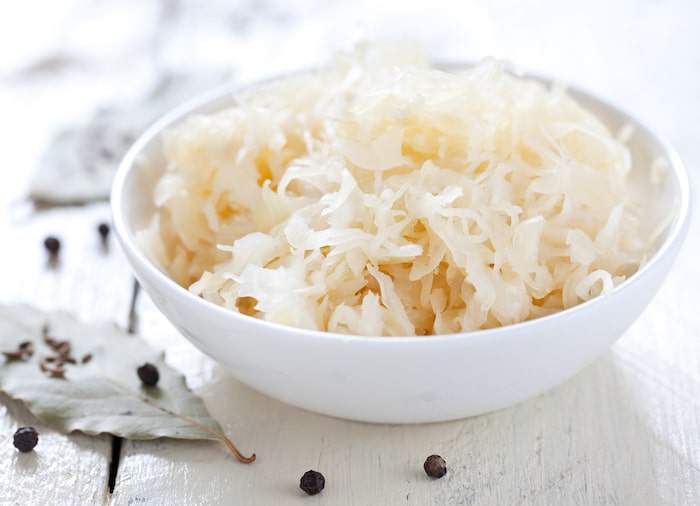
This sauerkraut recipe Is simple, inexpensive, delicious, full of health benefits, and made from just 2 ingredients with a little fermenting.
What’s not to love?!
This homemade sauerkraut recipe is an easy start to introduce you to the world of at-home fermentation. If this is your first time fermenting, this is a good way to dip your toes into the process to see what it’s all about.
It makes enough to fill about ½ of a large mason jar and just takes 3-4 days to ferment.
When you make this recipe, you’ll get to enjoy the tasty sauerkraut recipe at the end and reap the health benefits of probiotics in this naturally fermented food. Plus, you’ll get the satisfaction of making your own super-charged, gut-friendly sauerkraut at home. Win-win-win.
What is Sauerkraut?
Sauerkraut is a probiotic-rich superfood that is made from cabbage through the process of fermentation. It’s totally vegan- and flexitarian-friendly.
Lactic acid bacteria (Lactobacillus bacteria, to be exact) feed off the cabbage leaves’ sugars. This sauerkraut fermentation process results in a delicious, tangy flavor.
How is Sauerkraut Fermented?
Fermenting cabbage relies on a natural process called lacto-fermentation. The cabbage ferments from the naturally occurring Lactobacillus bacteria that live on the leaves. The process begins once it’s submerged in its own brining liquid after being combined with salt.
The liquid creates an anaerobic environment that allows fermentation to occur.
This is not your momma’s canned sauerkraut from the ’70s (and that’s a good thing!).
Somewhere along the way, big food companies figured out that they could replace the tangy taste of naturally fermented foods (dill pickles, sauerkraut, kimchi) by adding vinegar and canning certain ingredients. That means the canned, gross stuff pretending to be sauerkraut wasn’t actually a fermented food and had no health benefits.
Stick to the real fermented stuff. Real sauerkraut can be found in the refrigerated section of your store if you choose to buy it instead of making it.
Why is Sauerkraut Fermented?
Sauerkraut is fermented because this natural process preserves food.
In fact, it has been used for thousands of years and was the primary way of preserving food before the refrigerator came along.
The most significant benefit of eating fermented foods like sauerkraut is that the fermentation process creates a multitude of gut-friendly probiotics (beneficial bacteria).
Health Benefits of Sauerkraut
There are so many incredible health benefits of sauerkraut and other fermented vegetables. The primary health boost you get from sauerkraut is the large quantity of probiotics, otherwise known as “good bacteria.”
Benefits of sauerkraut include:
- Immune system boost
- Gut healing
- Glowing skin
- High in micronutrients, vitamins, and minerals
I love sauerkraut because it is just so healthy. It is vegan, dairy-free, and gluten-free, packed with dietary fiber. It’s also high in vitamins like vitamin C, Vitamin K, and minerals such as phosphorus, calcium, and potassium.
Oh, and did I mention sauerkraut is extremely low in carbohydrates (if that’s something you keep an eye on)?
What You Need to Make Sauerkraut
Here is the best part of this recipe—you only need 2 ingredients for this recipe: cabbage and kosher salt. I typically use green cabbage, but you can use red cabbage as well.
Make sure to gather a container with an airlock or a glass jar to store the kraut as it ferments. Grab a sharp knife and cutting board as well.
Now you’re ready to make this savory addition to sandwiches, potato salads, sausage cookouts, deviled eggs, and more.
How long does sauerkraut take to make?
Sauerkraut is a breeze to make. Prep included, it takes about 10 minutes total. Once it is fully fermented, it lasts about 6 months if kept in an airtight container in the refrigerator.
Tips for Making Sauerkraut
Although this recipe is seriously the easiest to make, I have a few tips to make the best sauerkraut.
Use Fresh Cabbage
This sounds like a no-brainer, but make sure to always use fresh cabbage, whether red or green, for this recipe. I love to pick up a cabbage from the farmer’s market for this recipe to get the complete farm-to-table feel.
Pick a High-Quality Salt
Now is not the time to use cheap table salt. Try using a mineral-rich kosher salt or pink Himalayan salt for this recipe. Your taste buds will thank you for choosing quality.
Use Enough Water
The cabbage must be fully submerged under the pickling brine for the fermentation process to continue. This allows the Lactobacillus bacteria to do their work and protects the sauerkraut from molding.
If the cabbage is not staying submerged, try using a jar on top of the fermenting jar as a weight or investing in fermenting weights (you can find these on Amazon).
How to Store Homemade Sauerkraut
I always store my homemade sauerkraut in a glass jar. I prefer a quart jar, but you can use larger or smaller jars depending on how much you’d like to make.
I would not recommend using a plastic bag like Ziploc for this recipe.
Whatever you choose, just make sure that your container is airtight—this will keep your sauerkraut fresh for longer and lessen the risk of mold.
Homemade Sauerkraut Recipe Notes:
- Fermentation time. In general, the smaller the batch, the shorter time it will take to ferment. The larger the batch, the longer it will take to ferment. We’re starting off here with about 1/2 of a head of a small to medium cabbage for the first batch. Fermenting should take about 3-4 days at room temperature.
- Flavoring. This is quite a basic recipe: just cabbage and kosher salt. If you want a traditional flavor with a little more kick, you can add 1/2 to one teaspoon of caraway seeds when you add the salt if desired. The beauty of making your own sauerkraut is that you can even add other spices and other veggies, too. You have complete control of what is going in your recipe.
- Ingredients. Look for organic cabbage, if possible, to keep the pesticides out of your homemade sauerkraut. I use the brand Real Salt sea salt. If the organic cabbage at your store is pricey, ask the produce staff to cut it in half for you—I do this almost every time I buy cabbage. Cabbage is dense and shredding creates a LOT of food, so you only need about 2 pounds to make this.
- Appearance. You can choose any cabbage you’d like, or mix different varieties for a really pretty sauerkraut. One part purple cabbage, one part green cabbage, and one part napa cabbage make for gorgeous color and texture in your sauerkraut. The good news is that it all tastes the same).
- Kids in the kitchen. This is a great “science experiment” to do with your kids every few weeks. Store it in the fridge and let them help you pick recipes and dishes that will complement your sauerkraut.
- Avoid these mistakes. One thing: do not buy pre-shredded or sliced cabbage—you need the lactobacillus bacteria living on the inner leaves. Most pre-shredded cabbage has been washed and/or irradiated. All store-bought produce in the US is irradiated (even organic), but only the outer leaves will be hit on a full head of cabbage. This is another reason to shop at your local farmers’ market.
I know I gave you a lot of notes here, but this is actually really simple and will take you less than 10 minutes to pull a batch of it together once you get the hang of it.
Here’s what my last batch looked like while it was fermenting. I used a box grater to shred the cabbage:
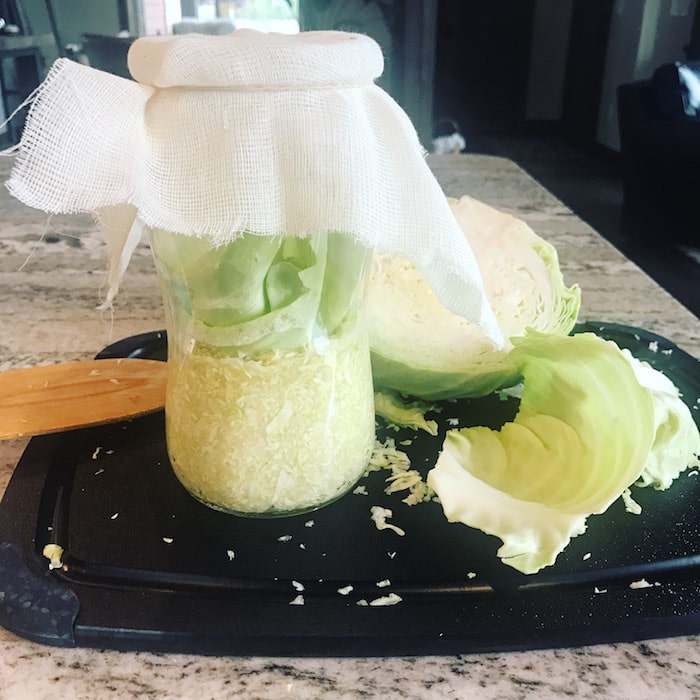
How to Make the Best Sauerkraut
You can print this recipe from the recipe card below.
Ingredients:
- 1/2 of a small to medium head of cabbage
- 1 1/2 tablespoons sea salt
You’ll need a clean cutting board, knife or box grater, mixing bowl, wide-mouth mason jar, cheesecloth or other cloth, and lid for your jar.
STEP 1: CLEAN
Wash your Mason jar, tools, and hands thoroughly with natural soap and hot water. When fermenting, you want to give the healthy bacteria a clean environment to thrive in to prevent mold.
I usually pour boiling water into and over the Mason jar after washing it with soap to kill off any potential lingering bacteria.
STEP 2: PREPARE
Cut your cabbage into quarters, leaving the root end attached. An attached root end makes the cabbage easier to chop or shred. Discard the outermost layers, then save a few of the next layers to weigh the cabbage down in the jar.
Do not wash the cabbage—you’re relying on the natural healthy bacteria that live on the leaves for the fermentation process.
STEP 3: SHRED
Choose your preferred texture. Thinly slice each cabbage quarter into ribbons, or shred it on a box grater for finer sauerkraut. As with all components, if you use the box grater, make sure it’s very clean.
STEP 4: MIX & MASSAGE
Add the shredded cabbage to a large mixing bowl and cover with salt. Using clean hands, massage the salt into the cabbage for about 30 seconds.
Let it sit for about 3-5 minutes to allow the salt to draw more liquid from the cabbage. Massage again for another 30 seconds.
This liquid is your fermenting brine, and there should be plenty of it.
STEP 5: FILL THE JAR
Add the shredded cabbage and all of the liquid/brine to your Mason jar. Use the back of a clean wooden spoon to tamp down the cabbage. It should be fully submerged in the brining liquid.
There shouldn’t be a lot of excess liquid, but the top of the cabbage should be fully underneath the brine. It can take 4-5 hours for enough juice to extract out of the cabbage and cover it.
You can allow that process to happen on its own. Just be sure to check back in on the shredded cabbage 4-5 hours after putting it in the jar to ensure that it is covered.
Keep using the back of your wooden spoon to push it down if needed. Place a few of the reserved cabbage leaves on top of the shredded cabbage to weigh it down.
If it hasn’t submerged after 4-5 hours: that’s ok; give it an hour more to sit. If it’s not submerged in an hour or so, add additional brine 1 tablespoon at a time.
To make the additional brine, combine 1/4 cup of water with 1/4 teaspoon sea salt. You can add a little to bring the brine just above the cabbage. This isn’t typically needed, but now you have the recipe just in case.
STEP 6: COVER
Cover the jar with cheesecloth or another loose, clean cloth and use a rubber band or kitchen twine to secure it. This allows airflow into the jar and prevents dust or bugs from landing in it.
STEP 7: FERMENT
Now it is fermentation time! Let the sauerkraut sit out at room temperature for 3-7 days. The longer it sits, the more fermented and tangy it will get.
Keep it at room temperature out of direct sunlight as the direct sunlight might overheat it. I let mine sit in the pantry or the back of the counter. Within about 24 hours, you’ll start to see tiny bubbles forming. That’s the lacto-fermentation in action.
STEP 8: REFRIGERATE
Once the sauerkraut is fermented to your liking, cover with a tight-fitting lid and store in the refrigerator for up to 2 weeks.
Homemade Sauerkraut Recipe Q&A:
- What can I add to sauerkraut? You can add so many things to sauerkraut—experiment with adding flavors like garlic, dill, celery root, lemon peel, fennel, or ginger. You can also add various other vegetables like beets, cucumbers, and onions to pickle with your sauerkraut.
- Why is sauerkraut bad for you? Homemade sauerkraut is not bad for you. In fact, it is extremely healthy! However, it can have higher levels of sodium depending on how much you add. As with every food, healthy moderation is best.
- How do you make sauerkraut taste better? You can make sauerkraut taste better by adding other flavors (see the list above for ideas) or lessening the fermentation time.
- What spices are good in sauerkraut? Good spices for homemade sauerkraut are dill, caraway seeds, juniper berries, celery seeds, and fennel.
- Do you rinse sauerkraut before cooking? I never rinse my sauerkraut before cooking it. The sauerkraut liquid is just brine, which is composed of salt and water.
- How will I know it’s done? It will taste like sauerkraut! It will be pleasantly tangy and delicious.
- What do you put sauerkraut on? How do I serve it? I love it alone, and it’s also suitable as a side dish, in salads, on a sandwich, burger, or just about anyplace you’d use pickles or something tangy. Never underestimate the power of tangy flavor to amp up the taste of your food. And probiotics are always a plus.
- What if there aren’t any bubbles and it’s not tangy? If your sauerkraut is missing both of these elements, it probably didn’t ferment. You may not have had enough salt, your cabbage was not organic and/or irradiated, or the temperature was too cold in your house. (I haven’t ever had this happen in my kitchen; I just wanted to note that it’s a possibility).
- What if I see mold in my sauerkraut? Throw it away—this means it did not properly ferment.
- What should I do with the leftover brine? The leftover brine is full of probiotics. You can drink it or whisk it with some olive oil for a tasty salad dressing.
- I love fermenting now, how do I make bigger batches? Awesome! Get a fermentation crock and have at it. Grab the book The Art of Fermentation, too, for even more ideas and instructions.
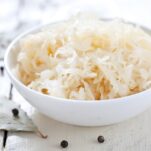
The Best 2-Ingredient Sauerkraut Recipe
- Prep Time: 15 mins
- Cook Time: 36 hours
- Total Time: 36 hours 15 mins
- Yield: 1 1x
- Category: Fermented
Description
This 2-ingredient sauerkraut recipe is one of our favorites. Not only is homemade sauerkraut delicious, but it’s also healthy and saves you money, too. Feel free to add 1/2 teaspoon of caraway seeds to the cabbage mix to add a traditional flavor to your sauerkraut. If you make it, please leave a star rating in the comments of this post to help other readers in our community (thank you!).
Ingredients
- 1/2 of a small to medium head of cabbage
- 1 1/2 tablespoons sea salt (I use Real Salt)
- Optional for flavor: 1/2 teaspoon caraway seeds
Instructions
- Clean: Wash your mason jar, tools, and hands thoroughly with natural soap and hot water. When fermenting, you want to give the healthy bacteria a clean environment to prevent mold. I usually pour boiling water into and over the Mason jar after washing it with soap to kill off any potential lingering bacteria.
- Prepare: Cut your cabbage into quarters, leaving the root end attached. Discard the outermost layers, then save a few of the next layers to weigh the cabbage down in the jar. Do not wash the cabbage—you’re relying on the natural healthy bacteria that live on the leaves for the fermentation process.
- Shred: Choose your preferred texture. Thinly slice each cabbage quarter into ribbons, or shred it on a box grater for finer sauerkraut. Same with the other tools, if you use the box grater, make sure it’s very clean.
- Mix & Massage: Add the shredded cabbage to a large mixing bowl and cover with salt. Using clean hands, massage the salt into the cabbage for about 30 seconds. It will start to release more liquid. Let it sit for about 3-5 minutes to allow the salt to draw more juice from the cabbage. Massage again for another 30 seconds. It will be very soupy, which is good! The resulting liquid is your fermenting brine.
- Fill the Jar: Add the shredded cabbage and all of the liquid/brine to your Mason jar. Use the back of a clean wooden spoon to tamp down the cabbage. It should be fully submerged in the brining liquid. There shouldn’t be a lot of excess liquid, but the top of the cabbage should be fully submerged. It can take 4-5 hours for enough liquid to extract out of the cabbage and cover it. Just be sure that the shredded cabbage is covered 4-5 hours after putting it in the jar. Place a few of the reserved cabbage leaves on top of the shredded cabbage to weigh it down.
- Cover: Cover the jar with cheesecloth or another loose, clean cloth and use a rubber band or kitchen twine to secure it. This allows airflow into the jar and prevents dust or bugs from landing in it.
- Ferment: Let the kraut sit out at room temperature for 3-7 days. The longer it sits, the more fermented and tangy it will get. In the warmer summer months, 3-4 days is perfect; I let it sit for 5-6 days in winter. Keep it at room temperature out of direct sunlight as the direct sunlight might overheat it. I let mine sit in the pantry or the back of the counter. Within about 24 hours, you’ll start to see tiny bubbles forming. That’s the lacto-fermentation in action.
- Refrigerate: Once it’s fermented to your liking, cover the sauerkraut with a tight-fitting lid and store it in the refrigerator for up to two weeks.
Nutrition
- Calories: 114
Other Recipes You’ll Love
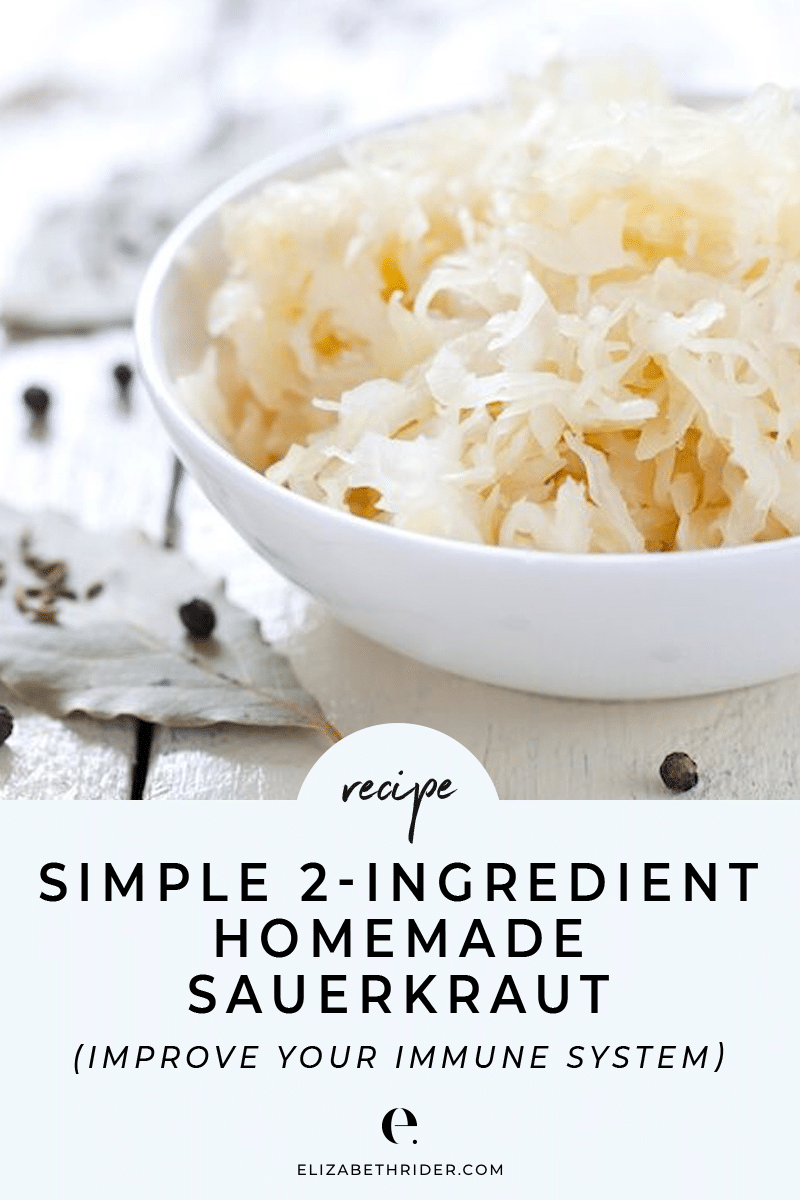

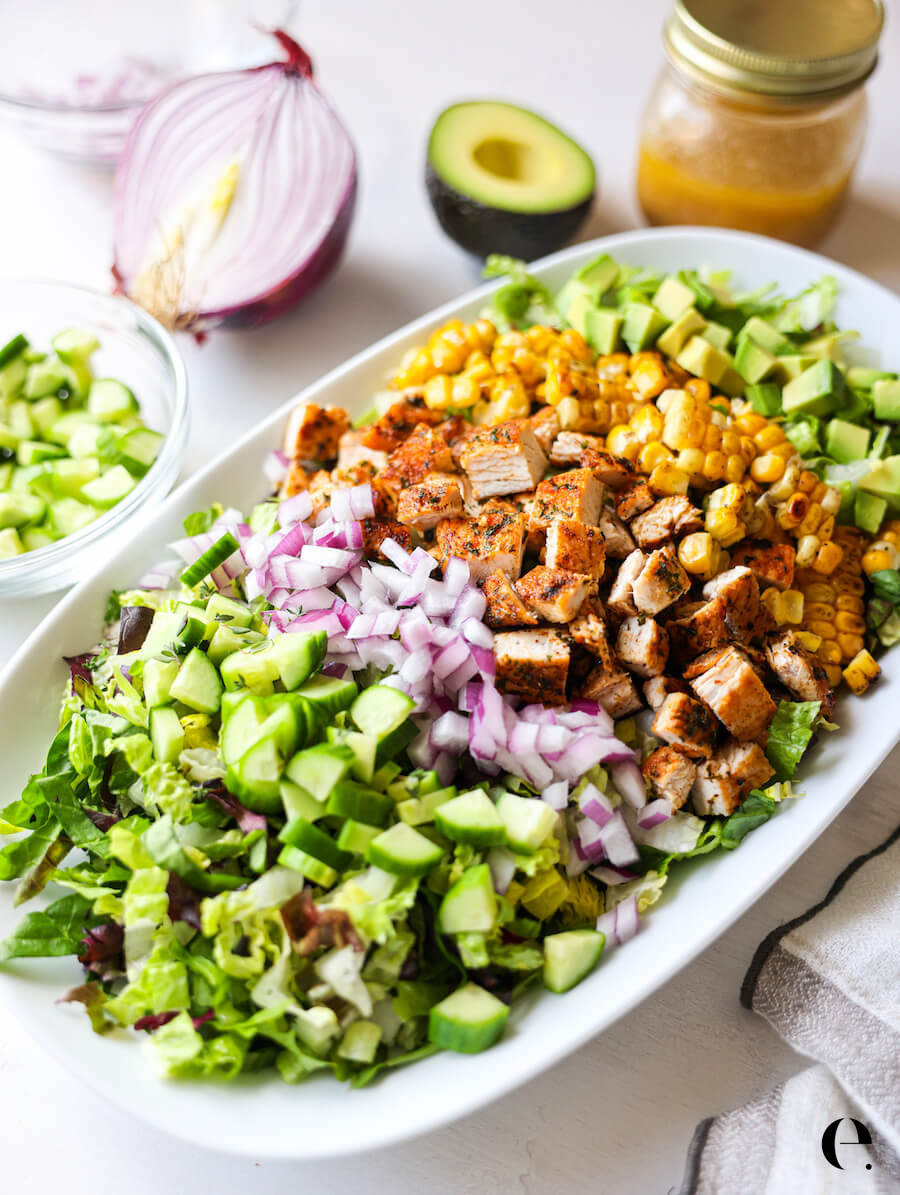



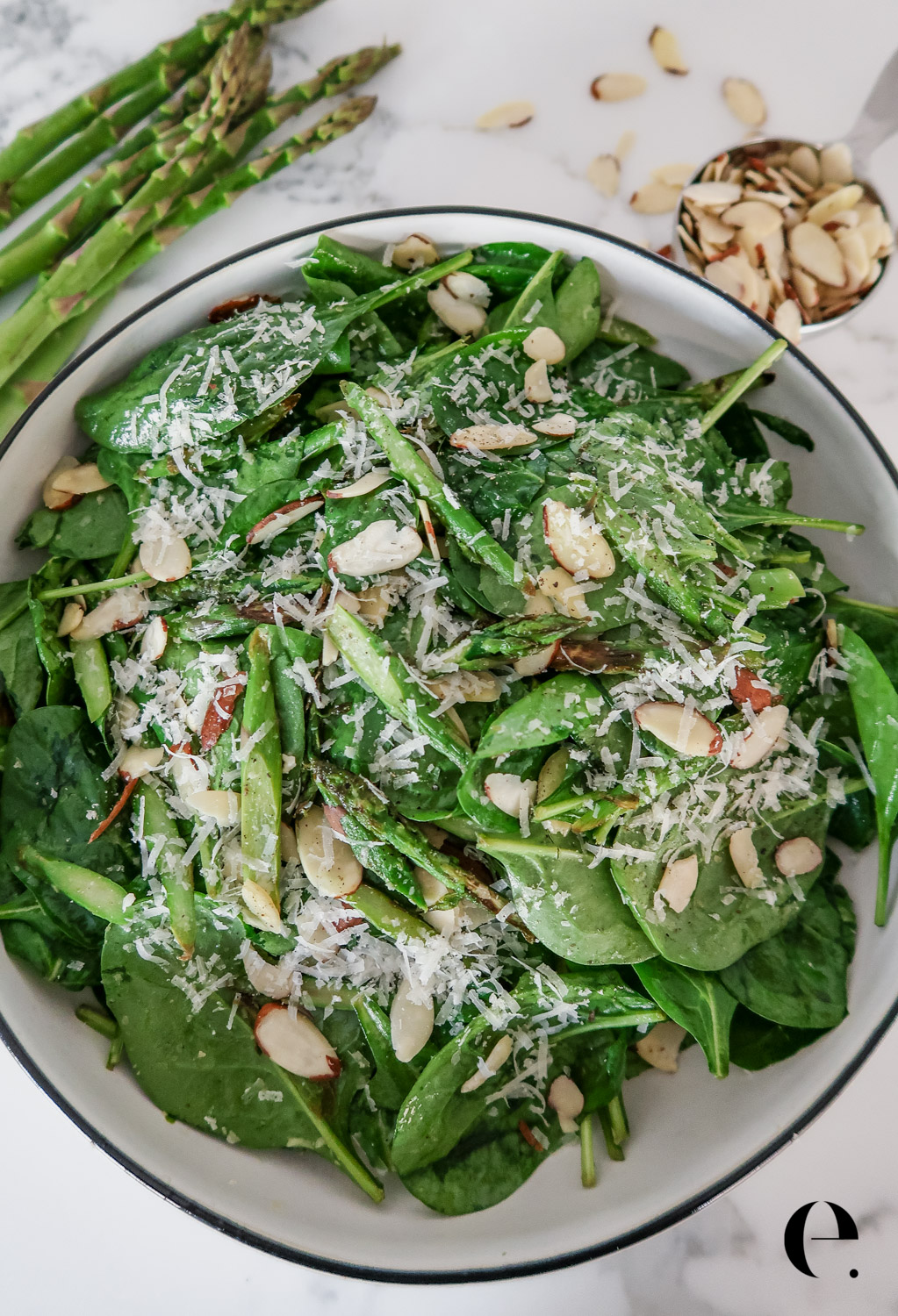

“All store-bought produce in the US is irradiated (even organic)”-direct quote from this post. On what source do you base this statement? I cannot find anyone reputable making a claim like this at all. As best as I can find, less than 1 percent of 10 percent is closer to the actual statistic for irradiated food in total, not even just produce. Having worked in the food industry my entire life, I’m shocked at this assertion. If you have any kind of actual proof, I’d like to know what it is, because this would be a giant news story that US citizens need to know.
I have let mine sit in the fridge for over a year and it’s still delicious.
Sunny, glad to hear it! Thanks for stopping by to share this with us. ~E